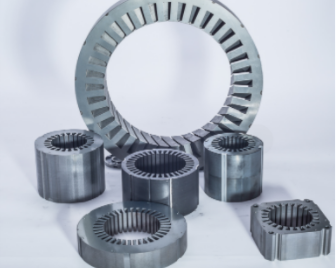What material is used for the core of a transformer?
Aug 20, 2025
Silicon steel (electrical steel)
• Characteristics: Silicon steel is the most traditional core material. By adding silicon (typically 3% to 5%), the resistivity is increased to reduce eddy current losses while maintaining high magnetic permeability. Cold-rolled silicon steel sheets have grain orientation, which can further optimize the magnetic flux path.
• Advantages: Low cost, high mechanical strength, and mature manufacturing process, suitable for power frequency (50/60Hz) applications.
• Disadvantages: Iron losses significantly increase at high frequencies (hysteresis loss + eddy current loss), and efficiency is lower than that of new materials.
• Applications:
• Power transformers (distribution and transmission systems);
• Industrial transformers (medium and low-frequency equipment).
2. Amorphous Alloy (Amorphous Steel)
• Characteristics: Metal glass structure with disordered atomic arrangement (such as iron-boron-silicon alloy), isotropic magnetism, significantly reducing eddy current and hysteresis losses. Iron loss is 70% to 80% lower than that of silicon steel.
• Advantages: Ultra-high efficiency (extremely low no-load loss), environmentally friendly and energy-saving.
• Disadvantages: High mechanical brittleness, difficult processing, relatively low saturation magnetic flux density (about 1.5T), and cost is 1.5 to 2 times that of silicon steel.
• Applications:
• High-efficiency distribution transformers (especially in energy-saving scenarios);
• Renewable energy systems (photovoltaic inverters, wind power transformers).
3. Ferrite
•Characteristics: Ceramic material (MnZn/NiZn-based), high resistivity (>10^6 Ω·m), naturally suppresses eddy currents, but magnetic permeability varies significantly with temperature.
•Advantages: Excellent high-frequency performance (1kHz - 1MHz), small size, moderate cost.
•Disadvantages: Low saturation flux density (<0.5T), brittle, not suitable for high-power low-frequency applications.
• Applications:
• Switching power supplies (SMPS), RF transformers;
• Consumer electronics (chargers, TVs, communication devices).
4.Nanocrystalline Materials
• Characteristics: Nanoscale crystalline structure (iron-based alloys), combining high saturation flux density (over 1.2T) with low high-frequency losses and good temperature stability.
• Advantages: Comprehensive performance surpasses ferrite, high-frequency losses comparable to amorphous alloys.
• Disadvantages: High cost, complex mass-production processes.
• Applications:
• High-end high-frequency transformers (medical equipment, aerospace);
• Electric vehicle charging modules.
Other Materials
• Iron Powder Cores: Used in mid-frequency inductors, strong anti-saturation capability but higher losses.
• Permalloy (Nickel-Iron Based): Extremely high initial permeability, used in precision instruments, but with exceptionally high cost.
Read More

 What impact does steel lamination punching have on motor performance?
What impact does steel lamination punching have on motor performance?